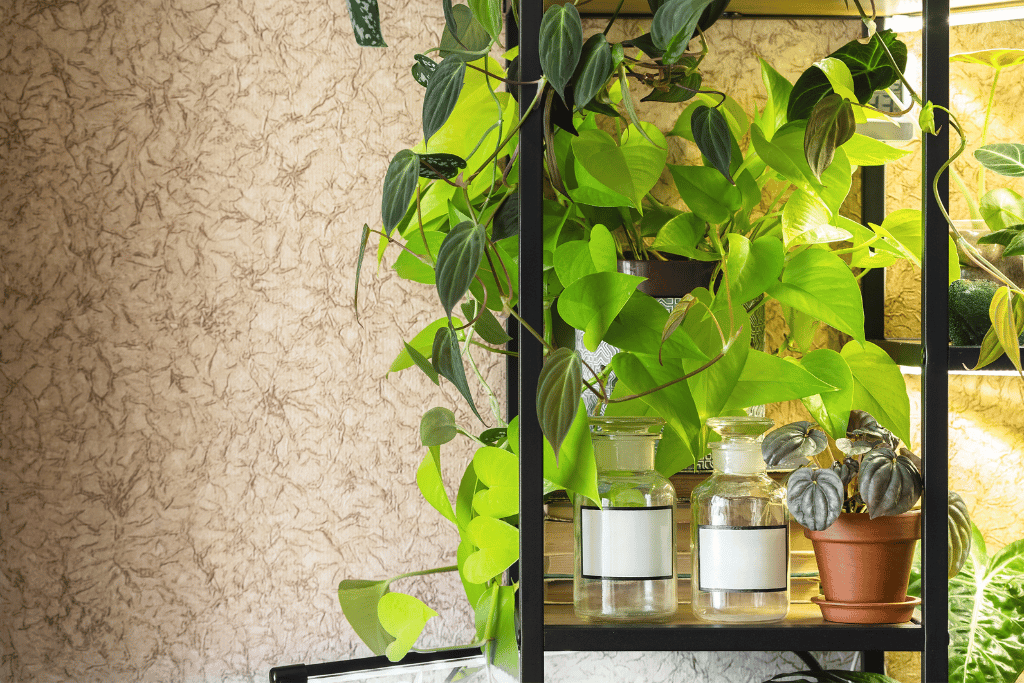Pothos, also known as Devil’s Ivy, is a very popular and commonly used houseplant which is easy to care for, being used to enhance a room’s appearance with its trailing vines and beautiful foliage. Another way to showcase your pothos is by having it climb a support structure, such as a trellis. In this article, we’ll discuss step-by-step how to train pothos to climb and some tips and tricks to ensure it grows healthily.

Step 1: Support Structure
Before you start training your pothos to climb, you’ll first need a support structure for it to grow over. Something such as a trellis or a moss pole would be ideal, but of course, there are many different structures you can grow it over. It should be tall enough to accommodate the full height of your plant and sturdy sufficient to hold the weight as well.
Step 2: Preparing the Pothos
We’re not quite ready to start training the pothos just yet. First, we need to make sure that the pothos is healthy and well-established. If you’ve just acquired a new pothos plant, it’s best to give it some time to settle into the conditions you are giving it, letting it establish a good root structure before training it. Make sure the plant is well-watered and that the soil is moist but not soggy (this can promote fungal growth as a result of overwatering)
Step 3: The Growing Tip
The growing tip of the pothos is the part which is actively growing, and it’s the part that we’re going to use as it’ll respond the best to training. You’ll need to locate the growing tip of the plant, which is usually located at the top of the plant. Bend it gently in the direction of the support structure – if the growing tip is already close to the support structure, you can skip this step.
Step 4: Attaching the Plant to the Support
Once you’ve located the growing tip and bent it in the correct direction of the support structure, you’ll need to attach the pothos to the support structure. I like to do this with something such as plant ties or twine. Make sure that you are careful with this step – you don’t want to tie it too tightly as this can restrict the movement of water and nutrients in the stem, restricting its growth which could eventually lead to the death of the stem or leaves.

Step 5: Monitor the Pothos
After attaching your pothos to the support structure, you’ll need to make sure that you’re monitoring its growth and adjusting the ties as necessary. As your pothos grows, the plant ties may need to be retied or adjusted to make sure that the plant is growing in the desired direction. Check the plant regularly for any signs of damage, such as browning leaves, stems or leaves dropping and take action to stop this if it occurs.
Valuable Tips and Tricks for Training Pothos to Climb:
- Provide the pothos with bright and indirect light. Direct sunlight will scorch the leaves, while insufficient light can slow down their growth and severely affect it.
- Trim back and yellow or brown leaves that develop, as this is typically a sign of overwatering or disease.
- Fertilize the pothos regularly, but make sure not to over-fertilize them. Too much fertilizer will burn the roots and damage the plant, inhibiting its growth. Fertilizing plants is essential and will help to speed up development.
- Keep the soil moist, not soggy. Overwatering can and will lead to root rot, which can kill the pothos.
- Most importantly – it would help if you were patient. Training pothos to climb can take time, and it may require some trial and error before you’ve finally got the hang of it.

Additionally, there are a few other considerations to keep in mind when training your pothos to climb. One crucial factor is the humidity levels in the place you are keeping the plant. Pothos plants prefer higher humidity levels, so if the room you are keeping it in is particularly dry, you need to consider adding additional moisture to the pothos. One such way of doing this is to place a tray of water near the plant to evaporate, mist the plant or use a humidifier.
Pothos plants are also toxic to pets if ingested, so keep this in mind when training them up a support structure. Cats, in particular, like to get adventurous, so try to keep them out of reach of any pets. If you can’t, then it’s best to get a non-toxic plant instead.
One other factor to consider is the size of the plant. If the pothos is already quite large, then it might be difficult to train it to climb. If so, then it would be best to prune back some of the growth to encourage new manageable growth, which can then be trained to climb. If you haven’t bought your pothos yet, though, consider this when looking for one.

Overall, training a pothos to climb up a support structure is quite a simple and enjoyable process that most people can do. It adds a lot of character to a room, helping to liven it up. With a bit of care and patience, your pothos will grow into a stunning climbing plant which is able to lighten up any room with its appearance.
Frequently Asked Questions (FAQ)
Why is my pothos not climbing?
If your pothos doesn’t seem to want to climb, it may be that there is a lack of light in the area that you want it to climb towards. If you’re growing pothos in a particularly dark room or corner, it’s likely not to grow well. Instead, try to get more light to reach that particular spot you’re growing it in by moving a few things around or, alternatively, moving to a completely different room. Hanging grow lights are usually a good option, but this might not be a good idea for most beginners.
When should you repot a pothos?
As a general rule of thumb, most houseplants can typically be repotted around every two to three years, depending on their size. When repotting your plants, you should make sure that you increase the pot size each time to make sure that the roots have sufficient space to grow into. When the plant’s root system has completely filled the pot, this is typically a good indicator that you should repot the plant. You can check this by simply sliding the plant out of the pot or checking the drainage holes at the bottom – if there are roots coming out, it’s likely that they don’t have much more space to grow into.
What kind of pots do pothos like?
Pots with drainage holes are an essential for pothos. Pothos plants don’t like to sit in wet soil, as their roots will rot. For the best growth, I would recommend planting pothos in a general well-draining potting mix to ensure adequate drainage. If you buy a pothos and the pot has no drainage holes, then it might be worth considering watering it less frequently or reducing the amount of water you give it until you can repot it at a safe time into a pot with drainage holes.
How big do pothos plants get?
In the wild, pothos plants are able to grow up to 60 feet (18 meters) when climbing up trees. When kept in outdoor climates that aren’t tropical, they can typically grow to around 20 feet (6 meters). Indoors, they are able to grow to around 10 feet.



